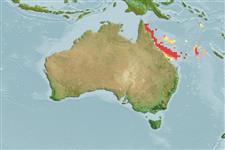>
Blenniiformes (Blennies) >
Blenniidae (Combtooth blennies) > Salariinae
Etymology: Ecsenius: Greek, exenios, -os, -on = uncontrolled, immoderate.
Environment: milieu / climate zone / intervalo de profundidade / distribution range
Ecologia
marinhas associadas(os) a recifes; intervalo de profundidade 1 - 20 m (Ref. 86942). Tropical
Western Pacific: known only from the Great Barrier Reef. More recently reported from the Chesterfield Islands (Ref. 11897).
Tamanho / Peso / Idade
Maturidade: Lm ? range ? - ? cm
Max length : 5.8 cm TL macho/indeterminado; (Ref. 2334)
Descrição breve
Chaves de identificação | Morfologia | Morfometria
Espinhos dorsais (total) : 12 - 13; Espinhos anais: 2; Raios anais moles: 15 - 17; Vértebras: 31 - 33. Dorsal fin XII or XIII (rarely XIII), 13-15, deeply incised between spinous and segmented-ray areas. Anal fin II,15-17. Pectoral fin 12-14 (rarely 12 or 14). Segmented caudal-fin rays 13. Vertebrae 10 + 21-23. Dentary incisor teeth which includes anterior canines very similar in appearance from incisors, 46-54 in males and 48 to 56 in females, averaging more in females than males; posterior canines 0 or 1 (usually 1). Lateral line without vertical pairs of pores, extending posteriorly to point between vertical from interspace between 9th and 10th spines and vertical from base of 11th dorsal-fin spine (rarely anterior to base of 10th spine). With cirrus on posterior rim of anterior nostril; absent on anterior rim. Posterior portion of body with sparse peppering of fine, dark spots (Ref. 5296).
Body shape (shape guide): elongated; Cross section: oval.
Adults feed mainly on a diet of coral polyps and mucous (Ref. 94105). Oviparous. Eggs are demersal and adhesive (Ref. 205), and are attached to the substrate via a filamentous, adhesive pad or pedestal (Ref. 94114). Larvae are planktonic, often found in shallow, coastal waters (Ref. 94114).
Life cycle and mating behavior
Maturidade | Reprodução | Desova | Ovos | Fecundidade | Larvas
Oviparous, distinct pairing (Ref. 205).
Randall, J.E., G.R. Allen and R.C. Steene, 1990. Fishes of the Great Barrier Reef and Coral Sea. University of Hawaii Press, Honolulu, Hawaii. 506 p. (Ref. 2334)
Categoria na Lista Vermelha da IUCN (Ref. 130435: Version 2025-1)
Ameaça para o homem
Harmless
Utilização humana
Ferramentas
Relatórios especiais
Descarregue XML
Fontes da internet
Estimates based on models
Preferred temperature (Ref.
123201): 24.7 - 28.4, mean 26.7 °C (based on 408 cells).
Phylogenetic diversity index (Ref.
82804): PD
50 = 0.5000 [Uniqueness, from 0.5 = low to 2.0 = high].
Bayesian length-weight: a=0.00776 (0.00356 - 0.01695), b=3.00 (2.81 - 3.19), in cm total length, based on LWR estimates for this (Sub)family-body shape (Ref.
93245).
Nível Trófico (Ref.
69278): 2.0 ±0.00 se; based on food items.
Resiliência (Ref.
120179): Elevada, tempo mínimo de duplicação da população menor que 15 meses (Preliminary K or Fecundity.).
Fishing Vulnerability (Ref.
59153): Low vulnerability (10 of 100).
🛈
Nutrients (Ref.
124155): Calcium = 235 [112, 443] mg/100g; Iron = 1.08 [0.60, 1.97] mg/100g; Protein = 17.7 [16.5, 18.9] %; Omega3 = 0.0909 [, ] g/100g; Selenium = 26.5 [11.5, 63.6] μg/100g; VitaminA = 115 [27, 483] μg/100g; Zinc = 3.32 [2.11, 4.99] mg/100g (wet weight);
